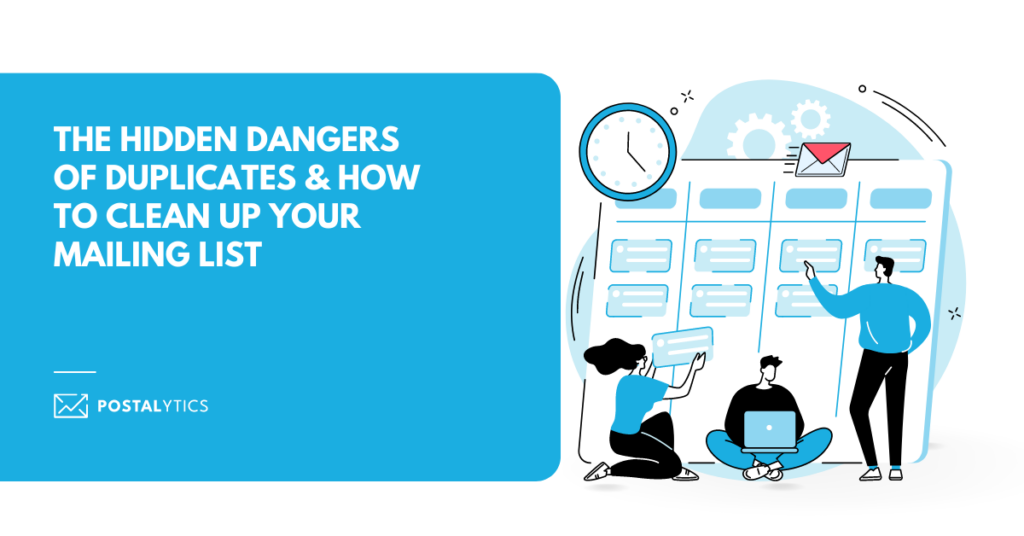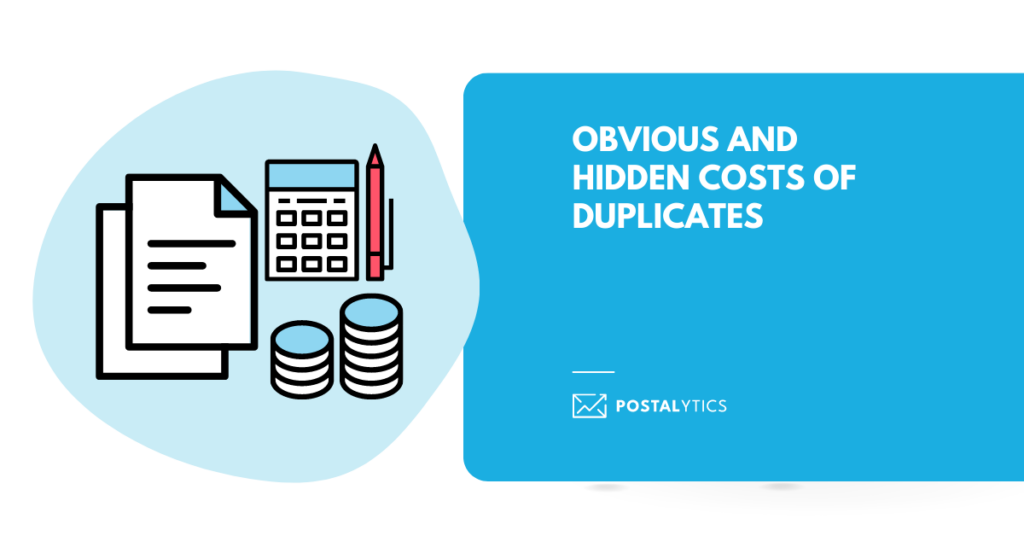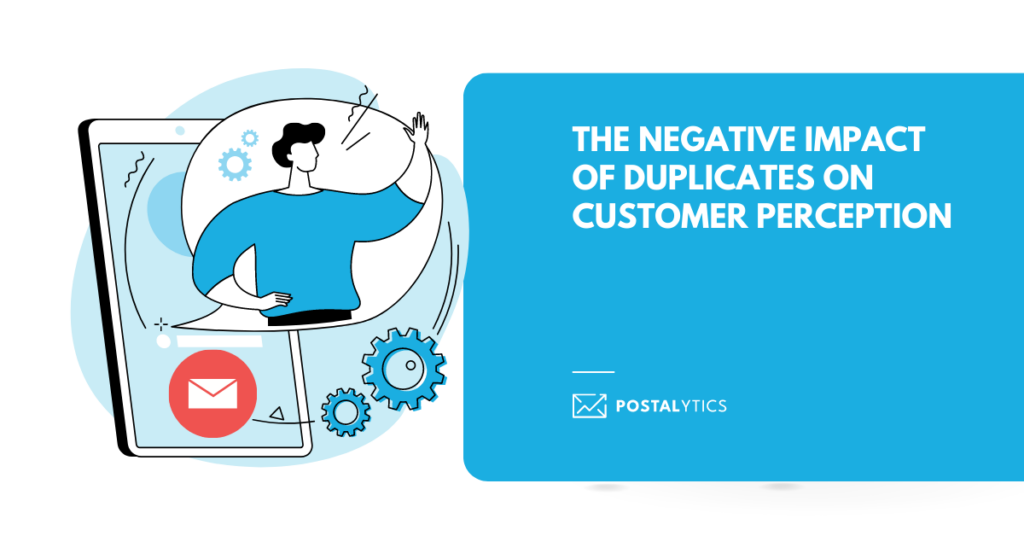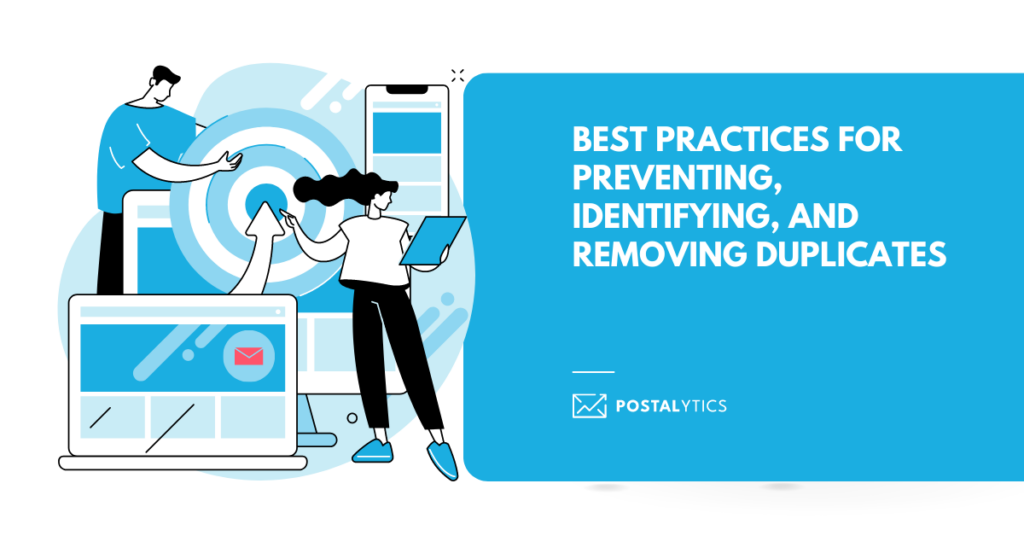
How many times have you sent out a mailing only to realize that John Doe at 123 Main Street got the same mailpiece three times?
Not only does this look unprofessional, but it’s also a complete waste of resources. It’s time we talk about duplicates in your mailing list.
Now, you might think, “It’s just a few duplicates. What’s the big deal?” But duplicates can cause lots of problems. You’re incurring extra costs for printing, mailing, and postage, not to mention the potential negative impact on your brand’s image.
Your mailing list is more than just a way to reach your customers; it’s a reflection of your attention to detail and your respect for customer individuality.
Every time your customers receive duplicate mail pieces, they get a message that says, “We don’t see you as an individual.” That’s not the impression you want to create.
But let’s not paint all duplicates with the same brush. Sometimes, you will want to send more than one mailpiece to the same address. Consider unrelated roommates, each with different tastes and varied shopping habits. In such cases, duplicates might not be so bad after all.
Let’s look at some things you should know about mailing list duplicates.
What We’ll Cover:
Obvious and Hidden Costs of Duplicates

Duplicates are more than just an annoyance-they’re costly. Every duplicate in your mailing list adds unnecessary expense for printing, mailing, and postage. If your campaign includes multiple communication channels, you might waste even more money sending duplicate messages via electronic means. If you’ve planned a campaign comprising a series of mailpieces, you’ll waste money on every mailing in the sequence.
Duplicates can make follow-up more difficult, too. When a customer responds to the mailpiece’s call-to-action, how is this behavior recorded in your CRM? Which of the duplicate records will track the customer interaction history, or will the history be split among multiple records in the database? You can see how duplicate data can easily muddle a carefully planned sales funnel strategy.
Duplicates can skew the results when you evaluate the ROI of a direct mail project. The extra money you spend to produce and distribute duplicate mailpieces is pure expense. Those duplicate mailpieces have no chance of producing any revenue to offset their cost. Any decisions you make about future projects may be flawed if they are based on the performance of mailing campaigns littered with duplicates.
Duplicate data has a cost even if you’re not mailing. Every time you access a data file with duplicates, it takes longer to run the job. You’ll also need storage space in the cloud or on-premise to store live data files and backups. Storage space costs money too.
Data analysis can be misleading as well, when your data includes duplicates. Let’s say you want to decide about opening a new physical retail location or hiring service technicians based on where your customers live. A file with too many duplicates might cause you to locate a store in the wrong part of town or set up service centers without enough business to justify the expense.
The Negative Impact of Duplicates on Customer Perception

Double mail tarnishes your company’s image in the eyes of your customers. This can harm your reputation and damage customer relationships–a cost that’s hard to quantify but crucial to your success.
Duplicates send a message that your company might be wasteful or lacks attention to detail. Imagine receiving two identical copies of the same mail. You’d probably think, “Don’t they have a system in place to prevent this?” Or perhaps, “Don’t they care about wasting resources?” In today’s world, where consumers are increasingly conscious about sustainability, this could be a major turnoff.
Next, duplicates can make customers feel like they’re just another number on your list. When they receive duplicate mail, they may perceive that your company doesn’t see them as unique individuals. The impact of personalization cannot be overstated. Sending customers duplicate mail is a step in the wrong direction.
Let’s say you include coupons or special offers in your mailpieces. What’s to stop a customer from attempting to redeem them more than once? This can either inflate the cost of your promotion or, if you reject the extra coupons, risk upsetting your customers. Either way, it’s a losing situation.
Regardless of how it happens, duplicate mailpieces can lead to negative customer experiences, which can harm your business’ reputation.
Defining Duplicates

What exactly represents a duplicate can differ, depending on your objectives. For instance, if you’re sending mail to a shared address, like a pair of family members or unrelated roommates, sending more than one mailpiece might be beneficial. These individuals could have different buying habits or fall into distinctive demographic categories. If you use variable data to match the offer and imagery to the recipient, the mailpieces would not be the same. In such a case, eliminating a duplicate based solely on the delivery address might be the wrong move.
However, if you’re sending multiple copies of the same mailpiece to a single individual, that’s a complete waste. It’s likely to annoy your customers and hurt their experience. To avoid this, it’s essential to have a system in place to detect and eliminate duplicates. A well-maintained mailing list is key to successful promotions and satisfied customers.
For many direct mail applications, the criteria for defining a duplicate is the customer’s name, plus their mailing address. If you do not keep your address list up to date though, your mailing could include duplicates without your knowledge, even if you “de-dupe” before mailing. This can easily happen when you combine your house list with a purchased list.
For many direct mail applications, the criteria for defining a duplicate is the customer’s name, plus their mailing address. If you do not keep your address list up to date though, your mailing could include duplicates without your knowledge, even if you “de-dupe” before mailing. This can easily happen when you combine your house list with a purchased list.
For example, the customer’s name on the purchased list may differ from how they appear on the house list. One file may list an individual as Robert Smith, while they appear on the other file as Bob Smith. If your matching software relies on exact matches, it won’t realize the same person is present in both files.
Another situation can be that the vendor supplying the purchased list updated the addresses according to the US Postal Service’s National Change of Address (NCOA) file. But you may not have done the same for your house file. Here, the house file would show the old address, while the purchased list contains the new address of a customer who has moved. If you mail First Class, your customer will probably receive two matching mailpieces. The USPS will attach a yellow sticker to one of them, indicating they forwarded the piece. (If you use Postalytics, we’ll update the old address for you. Your customer won’t see the yellow sticker, but they may still receive two mailpieces.
NOTE: Even worse than wasting money to mail an extra piece, failing to recognize purchased mailing list data as belonging to an existing customer can create uncomfortable situations. One of the mailpieces they receive may contain a special offer reserved for new customers only, for which your existing customer would not qualify!
Best Practices for Preventing, Identifying, and Removing Duplicates
Handling duplicates in your mailing list can feel a lot like playing a never-ending game of whack-a-mole. But fear not, we’re here to guide you through. Here are some of the best practices to help you find and remove those pesky duplicates:
- Regular Audits – Your first line of defense is conducting regular audits of your mailing list. Think of it as spring cleaning for your database. Regularly cleaning up your list can help you spot and remove duplicates before they become a problem. About 14% of the US population moves every year. If you haven’t used your mailing list in a while, it’s sorely out of date and more prone to accepting duplicate data.
- Use Postalytics – Direct mail automation platforms like Postalytics include data cleansing tools so there’s no need to comb through your mailing list manually. Let technology do the work! Check out this case study about a customer who solved their data quality issues and saved money using the built in de-duplication tools in Postalytics.
- Use 3rd party data cleaning software that can automatically detect and remove duplicates for you. Specialized software can identify near-matches and possible duplicates, even if the data is slightly different.
- Unique Identifiers – Assign unique identifiers to each customer in your list. This could be anything from an email address to a customer ID or account number. Unique identifiers help distinguish between different customers, even if they share the same name or address. The identifiers can also help you combine data from customers who are in your file twice, with different mailing addresses.
- Monitor New Entries – One common source of duplicates is when new entries are added to your mailing list, especially by customers via online forms. Be vigilant when adding new customers to your list. Check to see if they’re already in your system before adding them.
- Establish the Definition of a Duplicate – What constitutes a duplicate might vary depending on your marketing strategy. Create a clear definition of what a duplicate is for your company. Is it a customer receiving multiple mailpieces at the same address or at different addresses? Once you know what you’re looking for, it will be easier to spot and drop duplicates. You may have multiple duplicate definitions, depending on the material you are sending.
Dealing with duplicates in your mailing list is an essential step to avoid unnecessary costs and support a positive company image. Unwanted duplicates can incur extra expenses and give the impression of a wasteful or careless company. They can also affect customer experience, making them feel undervalued as individuals and causing potential issues with coupon redemptions.
Besides wasting money to produce and send duplicate mail, duplicate data can affect companies in other ways, including strategic planning and effective sales funnel management.
It’s crucial to clarify what signifies a duplicate for your company, as this can differ in various scenarios. Identifying and removing duplicates should be a priority for any organization that relies on address data to communicate with its prospects and customers.
About the Author

Dennis Kelly
Dennis Kelly is CEO and co-founder of Postalytics. Dennis joined Boingnet, the predecessor to Postalytics, in 2013. Boingnet was focused on providing print and direct mail marketing service providers the ability to add digital marketing channels to their direct mail campaigns. Postalytics is Dennis’ 6th startup. He has been involved in starting and growing early-stage technology ventures for over 30 years and has held senior management roles at a diverse set of large technology firms including Computer Associates, Palm Inc. and Achieve Healthcare Information Systems.
